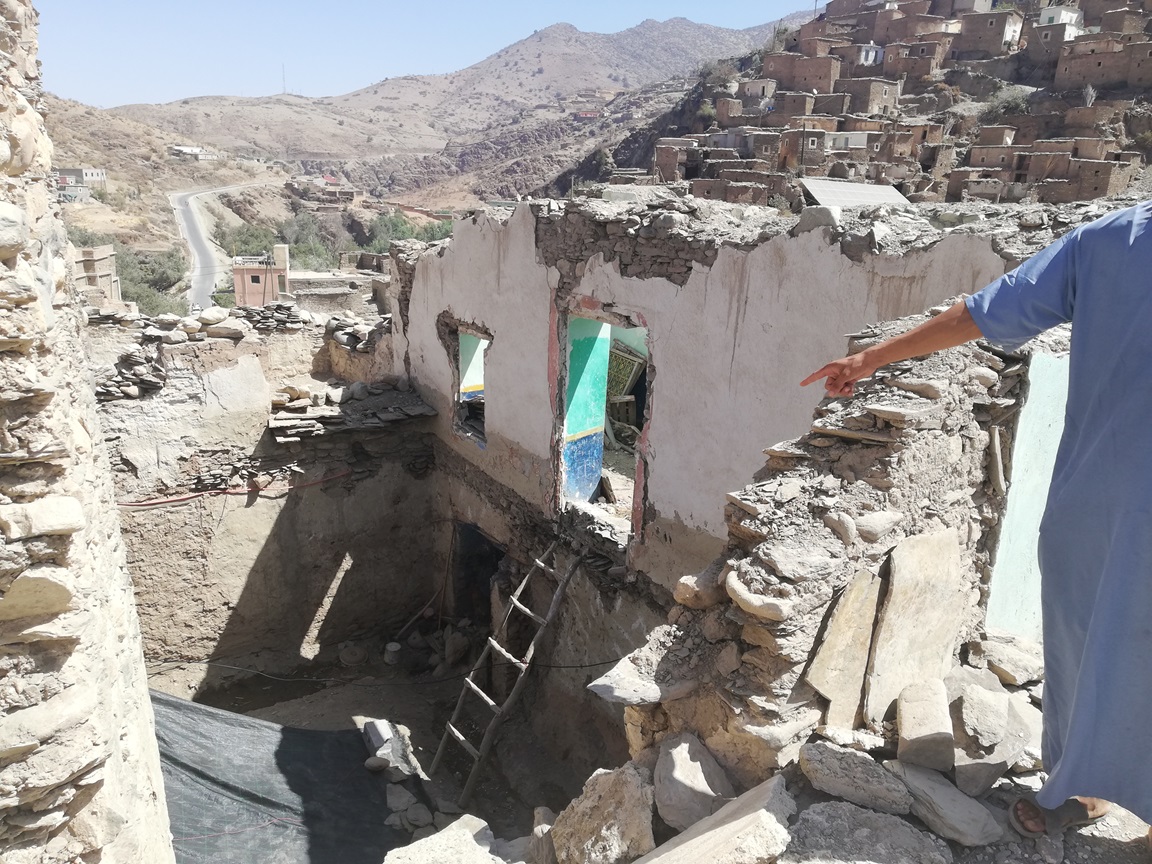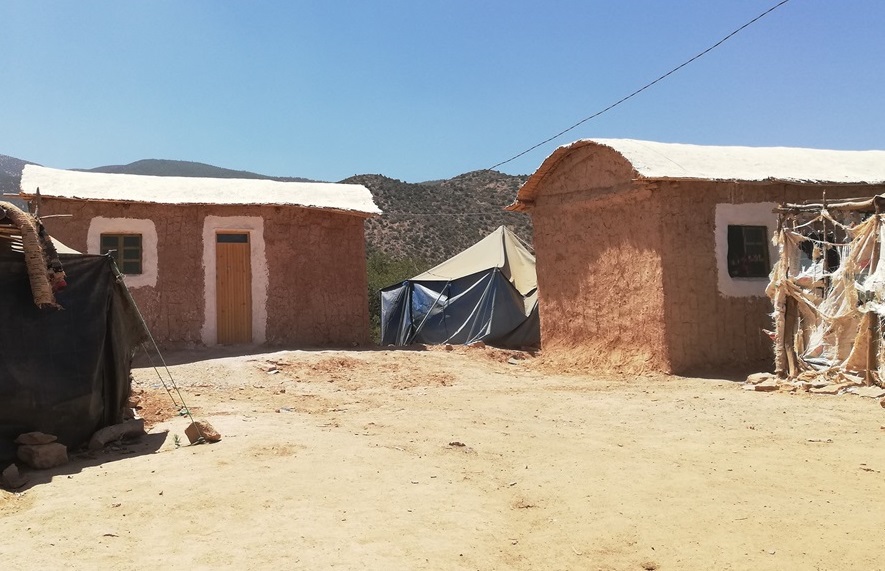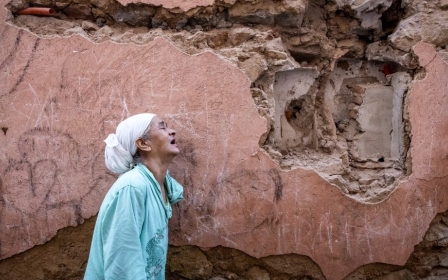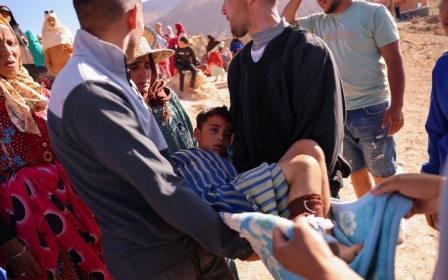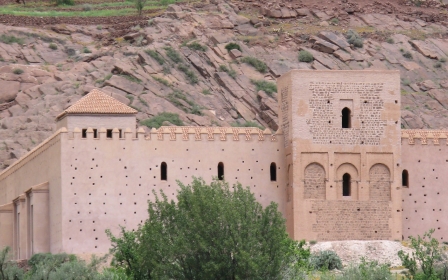Morocco: One year after the earthquake, those rebuilding are feeling left behind
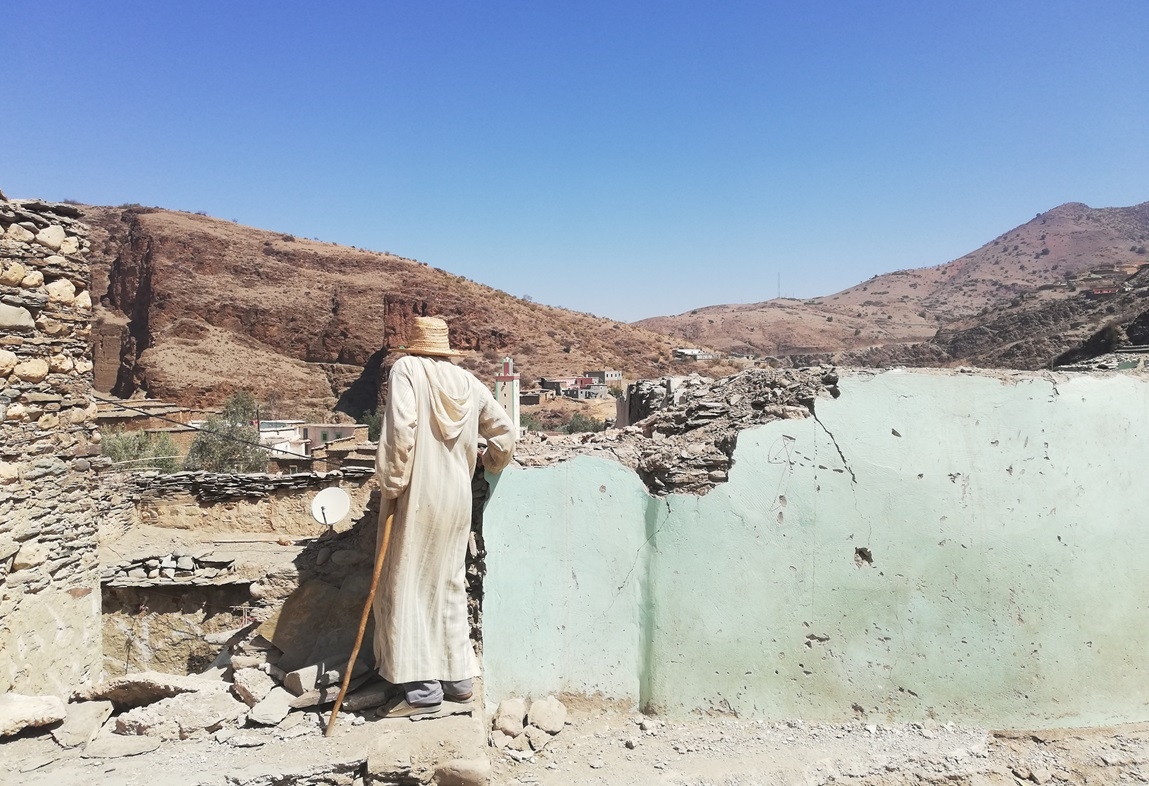
In the middle of the meandering paths that crisscross the mountainous douar (village) of Anebdour, a green metal door stands in contrast with the dark stone facade surrounding it.
In front of the door, an elderly man wearing a beige tagia hat struggled to open the padlock. With a creaking sound, it eventually opened on an astonishing view. Behind the door: emptiness. Of Omar's house, only a wall and this small door remained.
A metre below, the beginnings of foundations could be discerned. To get down there, the 80-year-old used his cane and a neighbour’s arm. He then showed his architect, Khalil Morad el-Ghilali, the trenches dug to build his new house.
The hamlet is located in the province of Chichaoua, a two-hour drive from Marrakech. The douar was hardly hit by the 6.8 magnitude earthquake that shook Morocco a year ago, on 8 September 2023.
Anebdour is about 30 kilometres away from the epicentre of the disaster that left 3,500 dead and 6,000 injured, and affected 60,000 homes, a third of which were completely destroyed.
New MEE newsletter: Jerusalem Dispatch
Sign up to get the latest insights and analysis on Israel-Palestine, alongside Turkey Unpacked and other MEE newsletters
Finalising the review with the architect, Omar tried to extricate himself from the vault, revealing the faded Adidas jogging pants he wore under his brown djellaba. All the time, he held tightly a colourful shopping bag containing the plans for his future house.
Omar then insisted on taking us a hundred metres further away. Under olive trees, three or four tents were standing. This is where the old man has been living, with the rest of his family, since the earthquake.
Here, Khadija, one of his relatives, invited us to visit her improvised home.
Under the tarpaulins, the air was stifling. It was the end of August when the outside temperature was reaching around 40 degrees.
The smiling young woman, wearing a black scarf with pink and red flowers, insisted on showing us what was hidden under the mass of sheets scattered across the floor covered with carpets: a baby, barely four months old, covered to protect him from the flies bustling around.
"Nowhere else did post-earthquake reconstruction take less than four years. However, we were told that in one year everything would be rebuilt. But this was impossible," el-Ghilali told Middle East Eye.
In Omar's village, residents whose houses were only cracked by the quake have recently started to return home after plugging the fissures. The authorities tried to dissuade them for safety reasons and "overzealousness", according to el-Ghilali.
After five months in the tents, they could not stand it anymore.
"This winter, even if fortunately it did not rain, there have been for two weeks gusts of wind so strong... that the tents flew away," a young man told MEE, while showing the many photos and videos kept on his smartphone to document his memories.
'This winter, even if fortunately, it did not rain, there have been for two weeks gusts of wind so strong... that the tents flew away'
- A victim of the quake
As for those whose houses collapsed or were demolished for complete reconstruction, they have been staying in the village's large guesthouse or with family members.
A handful of them, like Omar and his family, still live in tents.
According to figures released by the government earlier this week, nearly 50,000 homes are under construction or rehabilitation and approximately 1,000 households have completed their work.
In other localities closer to the epicentre, the majority of victims are still living in tents. Some plots of land have not yet been cleared, without any known reason.
The works have also faced more understandable problems. For instance, when the trenches for the foundations are dug in the exact place planned by the architect, they are not deep enough, el-Ghilali said.
Nearby, a young man showed MEE his hands full of blisters when the architect told him he had to continue digging to be authorised to build his slab.
Inaccessibility and inflation
In the days following the earthquake, emergency aid poured in from all over the kingdom and the Moroccan diaspora. A surge of generosity that was welcomed by all.
The state also quickly released financial aid of 2,500 dirhams (around $255) per month per household for the duration of one year. The aid is supposed to end next month.
On the other hand, the system chosen for the reconstruction has received criticism.
The state opted for supervised self-construction. After a survey of the damage conducted by the authorities, the victims were classified according to whether their homes had been completely or partially destroyed to receive direct aid of 140,000 dirhams (approximately $14,500) or 80,000 dirhams, paid in instalments.
It was then left up to the residents to arrange the construction work, either by themselves or hired labourers, according to the plans drawn up by the selected architect.
This however has represented a real challenge, given the lack of manpower and the difficulties in getting equipment and building materials on site, several residents told MEE.
In fact, because some hamlets are located on the mountainside and houses are only accessible after several minutes of walking on narrow dusty paths, the bricks can only be transported on donkeys, or at best by mopeds.
Another obstacle is inflation, both in terms of the price of construction materials and workers' daily wages.
There have also been administrative difficulties. For, example the lack of a national identity card or by mistake, some residents have not correctly been counted, several field workers told MEE.
"There was a degree of injustice," Elmahdi Benabdeljalil, chairman of Amal Biladi, an NGO that has been working in three disaster-stricken villages, told MEE.
Several residents also told MEE that they had not yet received the first payment, while their neighbours, in the same situation, had.
This is the case of two cousins, Driss and Abdelslam, in a douar comprising a few houses in Ait Bourd, in the province of Al Haouz, located an hour and a half southeast of Marrakech, by paved and dirt roads.
The pair, wearing djellabas and baseball caps, took MEE to a special place nearby, the rubble of their house: a nouala.
The concept was developed by architect Elie Mouyal, who was inspired by the traditional huts typical of some Moroccan regions, to design emergency housing units using local materials (logs, reeds, earth, etc).
The idea has been adopted with some modifications by Amal Biladi in the area hit by the earthquake: here, the huts are built using clay, wood and reeds.
While the chairman of the NGO was explaining its work to MEE, the men sitting around him were hanging on his every word.
"The idea is to build a temporary home in about ten days that can last as long as necessary while waiting for the houses to be built," Benabdeljalil said.
"The nouala is earthquake-resistant and, thanks to the insulation, it is less cold in winter and less hot in summer than tents," he added.
His NGO has helped about 20 households build them. About 30 additional noualas should be built by the end of the year, he told MEE.
'All-concrete' reconstruction
The techniques used to rebuild are also debated. The last 60 kilometres before arriving in Anebdour are strewn with countless quarries and tiny cement factories.
Along the way, small piles of a few dozen concrete bricks shape the roadsides, intended to build the new houses.
In places where houses built with traditional techniques and local materials such as earth and stones are still predominant, there is visibly a tendency to rebuild with concrete.
'While stone or earth constructions have proven that they hold steady, they are destroyed to build in cement bricks'
- Khalil Morad el-Ghilali, architect
And this is a real ecological aberration, according to el-Ghilali and other architects who have been trying to alert the public about this "all-concrete reconstruction".
The brick buildings look like carbuncles on the ochre mountain that has been covered, for centuries, by earth or stone buildings blending perfectly with the environment.
Besides, in the two high Atlas villages visited by MEE, it was easy to see that houses made of local materials had resisted the earthquake better than those built in concrete (or worse, those built with a mixture of the two in a completely disjointed way, for the upper floors).
But proof by example is seemingly not enough to convince the residents to opt for ancestral techniques. The desire to rebuild quickly, a denigration of the old in favour of the modern - or cheaper - seems to have defeated those ancient practices.
But el-Ghilali, who defends traditional materials, says that the costs can be equivalent. Other architects, though, argue that older techniques are much more expensive.
As he crossed the villages, Omar’s architect had difficulty hiding his disgust.
"Rehabilitations of houses in natural materials or concrete were refused by the authorities, whereas in some localities, rebuilding the existing structure would have been enough and allowed people to be sheltered more quickly," el-Ghilali told MEE.
According to him, the trend is rather to raze houses to the ground in order to rebuild completely from scratch, including when the structures are not completely destroyed.
The architect speculates that the rehabilitation of the existing buildings has not been validated because of, among other reasons, the bonanza that the disaster has represented for the cement industry.
MEE contacted the Moroccan Ministry of National Land Planning and Housing, as well as the Professional Association of Cement Manufacturers (APC) for comment but had not received a response by the time of publication.
"And then, while stone or earth constructions have proven that they hold steady, they are destroyed to build in cement bricks," el-Ghilali added.
Other architects told MEE that repairing cracked rammed-earth housing was relatively easy, as opposed to restoring houses made of concrete, which could be unsafe.
El-Ghilali also believes that even if rebuilding with traditional techniques was more expensive, the financial aspect should not be a sufficient obstacle, as more resources could be mobilised by the government.
"The state can put money into a football stadium but not in reconstruction here?" he asked rhetorically, in reference to the 5bn dirham (around $500m) stadium the kingdom is building ahead of the 2030 World Cup it will host with Spain and Portugal.
In Morocco, the future football event is on everyone's lips. Much more than the earthquake and its aftermath.
Middle East Eye delivers independent and unrivalled coverage and analysis of the Middle East, North Africa and beyond. To learn more about republishing this content and the associated fees, please fill out this form. More about MEE can be found here.



